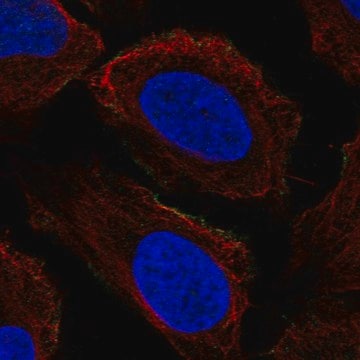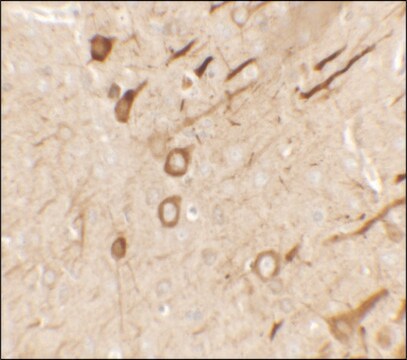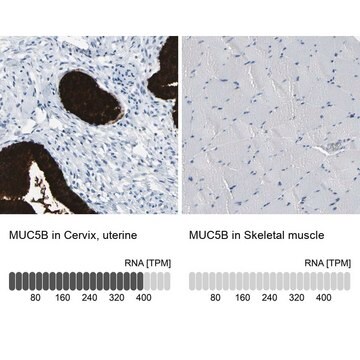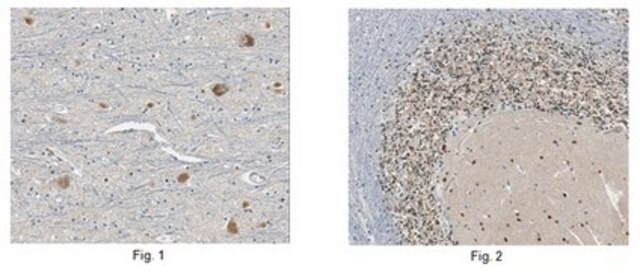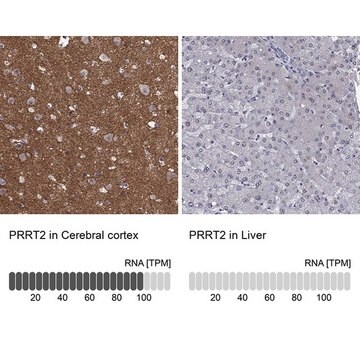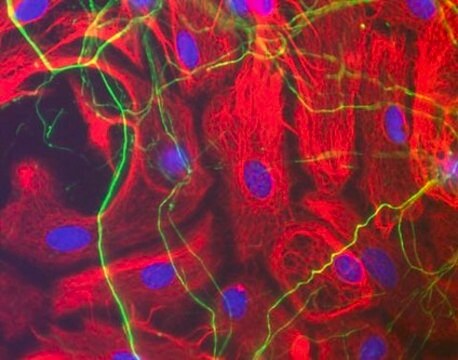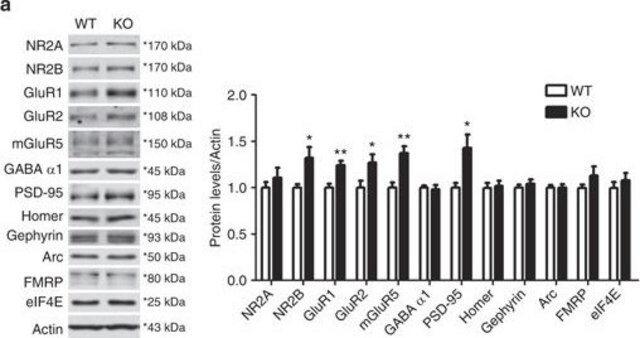HPA014447
Anti-PRRT2 antibody produced in rabbit

Prestige Antibodies® Powered by Atlas Antibodies, affinity isolated antibody, buffered aqueous glycerol solution
同義詞:
Anti-DKFZp547J199, Anti-FICCA, Anti-FLJ25513, Anti-ICCA, Anti-IFITMD1
登入查看組織和合約定價
全部照片(5)
About This Item
共軛:
unconjugated
application:
IHC
無性繁殖:
polyclonal
物種活性:
human
citations:
8
技術:
immunohistochemistry: 1:1000- 1:2500
推薦產品
生物源
rabbit
品質等級
共軛
unconjugated
抗體表格
affinity isolated antibody
抗體產品種類
primary antibodies
無性繁殖
polyclonal
產品線
Prestige Antibodies® Powered by Atlas Antibodies
形狀
buffered aqueous glycerol solution
物種活性
human
加強驗證
orthogonal RNAseq
Learn more about Antibody Enhanced Validation
技術
immunohistochemistry: 1:1000- 1:2500
免疫原序列
PKPALQPELPTQEDPTPEILSESVGEKQENGAVVPLQAGDGEEGPAPEPHSPPSKKSPPANGAPPRVLQQLVEEDRMRRAHSGHPGSPRGSLSRHPSSQLAGPGVEGGEGTQKPRDY
UniProt登錄號
運輸包裝
wet ice
儲存溫度
−20°C
目標翻譯後修改
unmodified
基因資訊
human ... PRRT2(112476)
免疫原
Proline-rich transmembrane protein 2 recombinant protein epitope signature tag (PrEST)
應用
All Prestige Antibodies Powered by Atlas Antibodies are developed and validated by the Human Protein Atlas (HPA) project and as a result, are supported by the most extensive characterization in the industry.
The Human Protein Atlas project can be subdivided into three efforts: Human Tissue Atlas, Cancer Atlas, and Human Cell Atlas. The antibodies that have been generated in support of the Tissue and Cancer Atlas projects have been tested by immunohistochemistry against hundreds of normal and disease tissues and through the recent efforts of the Human Cell Atlas project, many have been characterized by immunofluorescence to map the human proteome not only at the tissue level but now at the subcellular level. These images and the collection of this vast data set can be viewed on the Human Protein Atlas (HPA) site by clicking on the Image Gallery link. We also provide Prestige Antibodies® protocols and other useful information.
The Human Protein Atlas project can be subdivided into three efforts: Human Tissue Atlas, Cancer Atlas, and Human Cell Atlas. The antibodies that have been generated in support of the Tissue and Cancer Atlas projects have been tested by immunohistochemistry against hundreds of normal and disease tissues and through the recent efforts of the Human Cell Atlas project, many have been characterized by immunofluorescence to map the human proteome not only at the tissue level but now at the subcellular level. These images and the collection of this vast data set can be viewed on the Human Protein Atlas (HPA) site by clicking on the Image Gallery link. We also provide Prestige Antibodies® protocols and other useful information.
生化/生理作用
The gene PRRT2 (proline rich transmembrane protein 2) encodes a 340 amino acid, transmembrane protein that is rich in proline. The gene is mapped to human chromosome 16p11.2. The mRNA is mainly expressed in the cerebral cortex and basal ganglia. The function of this protein is yet to be characterized. However, mutations in this gene cause episodic kinesigenic dyskinesia-1, leading to epilepsy and movement disorder.
特點和優勢
Prestige Antibodies® are highly characterized and extensively validated antibodies with the added benefit of all available characterization data for each target being accessible via the Human Protein Atlas portal linked just below the product name at the top of this page. The uniqueness and low cross-reactivity of the Prestige Antibodies® to other proteins are due to a thorough selection of antigen regions, affinity purification, and stringent selection. Prestige antigen controls are available for every corresponding Prestige Antibody and can be found in the linkage section.
Every Prestige Antibody is tested in the following ways:
Every Prestige Antibody is tested in the following ways:
- IHC tissue array of 44 normal human tissues and 20 of the most common cancer type tissues.
- Protein array of 364 human recombinant protein fragments.
聯結
Corresponding Antigen APREST72953
外觀
Solution in phosphate-buffered saline, pH 7.2, containing 40% glycerol and 0.02% sodium azide
法律資訊
Prestige Antibodies is a registered trademark of Merck KGaA, Darmstadt, Germany
免責聲明
Unless otherwise stated in our catalog or other company documentation accompanying the product(s), our products are intended for research use only and are not to be used for any other purpose, which includes but is not limited to, unauthorized commercial uses, in vitro diagnostic uses, ex vivo or in vivo therapeutic uses or any type of consumption or application to humans or animals.
未找到適合的產品?
試用我們的產品選擇工具.
儲存類別代碼
10 - Combustible liquids
水污染物質分類(WGK)
WGK 1
閃點(°F)
Not applicable
閃點(°C)
Not applicable
個人防護裝備
Eyeshields, Gloves, multi-purpose combination respirator cartridge (US)
Louise Robertson et al.
Genes, brain, and behavior, 18(5), e12566-e12566 (2019-03-19)
Mutations in proline-rich transmembrane protein 2 (PRRT2) cause a range of episodic disorders that include paroxysmal kinesigenic dyskinesia and benign familial infantile epilepsy. Mutations are generally loss of function and include the c649dupC frameshifting mutation that is present in around
Dylan J Calame et al.
Neuroscience, 448, 272-286 (2020-09-07)
PRRT2 loss-of-function mutations have been associated with familial paroxysmal kinesigenic dyskinesia (PKD), infantile convulsions and choreoathetosis, and benign familial infantile seizures. Dystonia is the foremost involuntary movement disorder manifest by patients with PKD. Using a lacZ reporter and quantitative reverse-transcriptase
Hao-Yang Feng et al.
Journal of clinical laboratory analysis, 36(2), e24196-e24196 (2022-01-09)
Proline-rich transmembrane protein 2 (PRRT2) is a neuron-specific protein associated with seizures, dyskinesia, and intelligence deficit. Previous studies indicate that PRRT2 regulates neurotransmitter release from presynaptic membranes. However, PRRT2 can also bind AMPA-type glutamate receptors (AMPARs), but its postsynaptic functions
Sarah E Heron et al.
American journal of human genetics, 90(1), 152-160 (2012-01-17)
Benign familial infantile epilepsy (BFIE) is a self-limited seizure disorder that occurs in infancy and has autosomal-dominant inheritance. We have identified heterozygous mutations in PRRT2, which encodes proline-rich transmembrane protein 2, in 14 of 17 families (82%) affected by BFIE
Elisa Savino et al.
Cells, 10(10) (2021-10-24)
Mutations in the PRRT2 gene are the main cause for a group of paroxysmal neurological diseases including paroxysmal kinesigenic dyskinesia, episodic ataxia, benign familial infantile seizures, and hemiplegic migraine. In the mature central nervous system, the protein has both a
我們的科學家團隊在所有研究領域都有豐富的經驗,包括生命科學、材料科學、化學合成、色譜、分析等.
聯絡技術服務